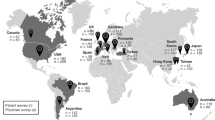Abstract
Objective
To determine the prevalence, factors associated with and patterns of concomitant Chinese medicine (CM) with Western treatment use among patients with rheumatoid arthritis (RA) in a tertiary referral centre (Singapore General Hospital) in Singapore.
Methods
We conducted a cross-sectional interviewer-administered survey of a consecutive sample of patients with RA in Singapore General Hospital centre regarding their CM use including data on patient demographics, disease characteristics, concomitant use of CM and reasons, concerns and disclosure patterns from March to August 2015. Univariate and multivariate logistic regression analyses were performed to determine the associations of CM use.
Results
Prevalence of CM use among the 258 patients surveyed (male: female 42: 216; Chinese: Malay: Indian 191: 29: 34; mean age: 61 years; mean duration of RA: 10 years) was 46.1% (119/258). On multivariate analysis, Chinese ethnicity (OR, 95% CI: 4.11, 1.49–11.36), Chinese speakers (OR, 95% CI: 2.35, 1.03–5.54), middle-income group (OR, 95% CI: 2.53, 1.01–6.31) and greater learned helplessness (OR, 95% CI: 1.13, 1.04–1.22) were significantly associated with CM use. More CM users disclosed their CM use to CM physicians (87.3%, 96/110), sought advice from them on treatment interactions (59.4%, 57/96) and how best to combine treatments (49.0%, 47/96) than did so with rheumatologists (42.0%, 50/119; 40.0%, 20/50; and 42.0%, 21/50, respectively). Forty-two percentage (29/69) of patients who concealed CM use from rheumatologists because their rheumatologists did not specifically enquire about CM use.
Conclusions
Concomitant CM use among patients with RA treated in a tertiary referral centre in Singapore is high but voluntary disclosure is low. The associations identified can help doctors identify and enquire about CM use, minimizing potential adverse interactions.
Similar content being viewed by others
References
Chandrashekara S. Complementary and alternative medicine in rheumatoid arthritis. Chin J Integr Med 2011;17:731–734.
Tan MG, Win MT, Khan SA. The use of complementary and alternative medicine in chronic pain patients in Singapore: a single-centre study. Ann Acad Med Sing 2013;42:133–137.
Su D, Li L. Trends in the use of complementary and alternative medicine in the United States: 2002–2007. J Health Care Poor Underserved 2011;22:296–310.
Seca S, Miranda D, Cardoso D, Nogueira B, Greten HJ, Cabrita A, et al. Effectiveness of acupuncture on pain, physical function and health-related quality of life in patients with rheumatoid arthritis: a systematic review of quantitative evidence. Chin J Integr Med 2019;25:704–709.
Tamhane A, McGwin G Jr, Redden DT, Hughes LB, Brown EE, Westfall AO, et al. Complementary and alternative medicine use in African Americans with rheumatoid arthritis. Arthritis Care Res (Hoboken) 2014;66:180–189.
Efthimiou P, Kukar M, Mackenzie CR. Complementary and alternative medicine in rheumatoid arthritis: no longer the last resort! HSS J 2010;6:108–111.
Tokem Y, Parlar Kilic S, Ozer S, Nakas D, Argon G. A multicenter analysis of the use of complementary and alternative medicine in Turkish patients with rheumatoid arthritis: holistic nursing practice review copy. Holist Nurs Pract 2014;28:98–105.
Lee MS, Yang CY, Lee SI, Joo MC, Shin BC, Yoo WH, et al. Use of complementary and alternative medicine by rheumatoid arthritis patients in Korea. Clin Rheumatol 2008;27:29–33.
Lim MK, Sadarangani P, Chan HL, Heng JY. Complementary and alternative medicine use in multiracial Singapore. Complement Ther Med 2005;13:16–24.
Leong KP, Pong LY, Chan SP. Why lupus patients use alternative medicine? Lupus 2003;12:659–664.
Zhang P, Li J, Han Y, Yu XW, Qin L. Traditional Chinese medicine in the treatment of rheumatoid arthritis: a general review. Rheumatol Int 2010;30:713–718.
Alaaeddine N, Okais J, Ballane L, Baddoura RM. Use of complementary and alternative therapy among patients with rheumatoid arthritis and osteoarthritis. J Clin Nurs 2012;21:3198–3204.
National Institutes of Health. Acupuncture. NIH consensus statement online. United States, 3–5 Nov, 1997. National Institutes of Health. 1997;15:1–34.
Schmier JK, Halpern MT. Patient recall and recall bias of health state and health status. Expert Rev Pharmacoecon Outcomes Res 2004;4:159–163.
Brady TJ. Measures of self-efficacy, helplessness, mastery, and control: The Arthritis Helplessness Index (AHI)/Rheumatology Attitudes Index (RAI), Arthritis Self-Efficacy Scale (ASES), Children’s Arthritis Self-Efficacy Scale (CASE), Generalized Self-Efficacy Scale (GSES), Mastery Scale, Multi-Dimensional Health Locus of Control Scale (MHLC), Parent’s Arthritis Self-Efficacy Scale (PASE), Rheumatoid Arthritis Self-Efficacy Scale (RASE), and Self-Efficacy Scale (SES). Arthritis Care Res 2003;49:S147–S164.
Thumboo J, Fong KY, Chan SP, Leong KH, Feng PH, Thio ST, et al. The Rheumatology Attitudes Index and its helplessness subscale are valid and reliable measures of learned helplessness in Asian patients with systemic lupus erythematosus. J Rheumatol 1999;26:1512–1517.
Key household income trends, 2014. 2015. Accessed September 22, 2015. Available from: http://www.singstat.gov.sg/docs/default-source/default-document-library/publications/publications_and_papers/household_income_and_expenditure/pp-s21.pdf.
Public housing in Singapore: examining fundamental shifts. 2014. Accessed September 22, 2014. Available from: https://lkyspp.nus.edu.sg/wp-content/uploads/2014/11/Public-Housing-in-Singapore.pdf.
Sato A. Does socio-economic status explain use of modern and traditional health care services? Soc Sci Med 2012;75:1450–1459.
Jacobs JWG, Kraaimaat FW, Bijlsma JW. Why do patients with rheumatoid arthritis use alternative treatments? Clin Rheumatol 2001;20:192–196.
la Cour P. Rheumatic disease and complementary-alternative treatments: a qualitative study of patient’s experiences. J Clin Rheumatol 2008;14:332–337.
Jong MC, van de Vijver L, Busch M, Fritsma J, Seldenrijk R. Integration of complementary and alternative medicine in primary care: what do patients want? Patient Educ Couns 2012;89:417–422.
Author information
Authors and Affiliations
Contributions
Huang YY, Thumboo J and Yong FK designed, conceived and revised the study. Huang YY and Xin XH carried out the survey, analysis and drafting. Rehena S analysed and interpreted the data. All authors have read and approved this manuscript.
Corresponding author
Ethics declarations
No conflict of interest to disclose.
Rights and permissions
About this article
Cite this article
Huang, Yy., Xin, Xh., Sultana, R. et al. Prevalence and Factors Associated with Concomitant Chinese Medicine Use by Rheumatoid Arthritis Patients in A Multi-Ethnic Asian Population. Chin. J. Integr. Med. 28, 223–228 (2022). https://doi.org/10.1007/s11655-021-3494-3
Accepted:
Published:
Issue Date:
DOI: https://doi.org/10.1007/s11655-021-3494-3



